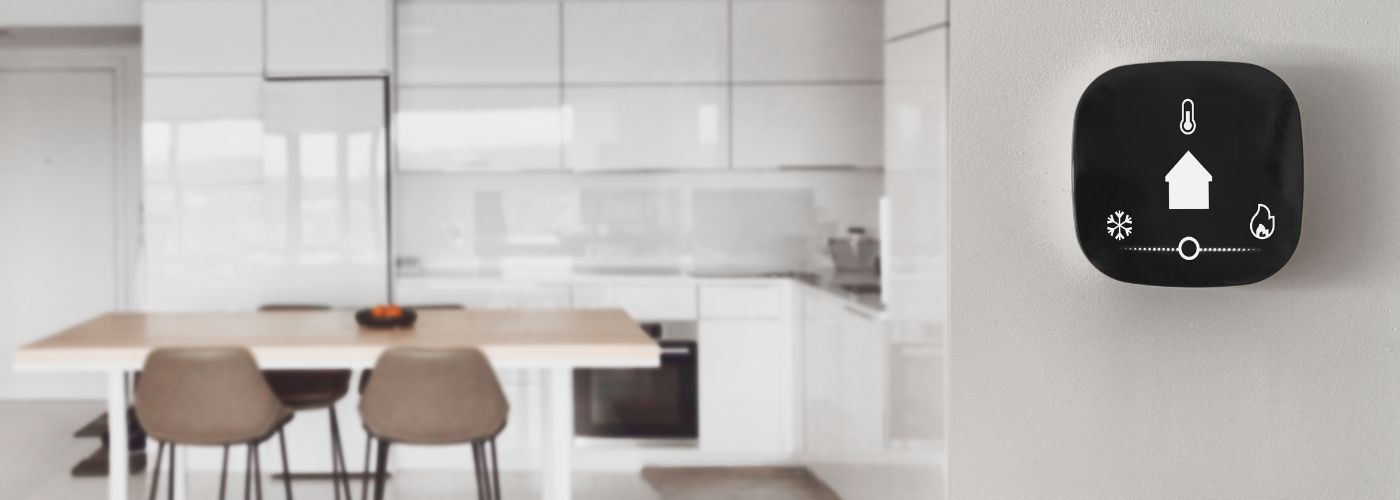Smart thermostats have revolutionized the way we control and manage the temperature in our homes, providing convenience, energy efficiency, and cost savings.
In this comprehensive guide, we’ll delve into the workings of smart thermostats, explore the installation process, address safety concerns, and discuss the potential financial benefits they offer.
How Do Smart Thermostats Work?
Smart thermostats go beyond traditional thermostats by incorporating advanced technology and connectivity features.
As an integral part of any smart home, smart thermostats often come equipped with sensors that detect factors like occupancy, humidity, and ambient temperature. Built-in learning algorithms analyze your heating and cooling patterns to create personalized schedules!
Most smart thermostats connect to your home’s Wi-Fi network, enabling remote control through smartphone apps or voice commands. This connectivity allows you to adjust settings from anywhere with an internet connection. Just as importantly, smart thermostats are designed to integrate seamlessly with popular smart home ecosystems, such as Google Home or Amazon Alexa. This integration enables voice control and coordination with other connected devices.
Smart thermostats often provide insights into your energy usage patterns. They track how and when your heating or cooling system operates, allowing you to make informed decisions to optimize energy efficiency.
Some smart thermostats utilize geofencing technology to detect when you’re approaching or leaving home. This feature can automatically adjust the temperature based on your proximity, ensuring comfort when you’re home and energy savings when you’re away.
How To Install A Smart Thermostat
Installing a smart thermostat is generally a straightforward process, but as with any element of smart home basics, it’s essential to follow the manufacturer’s instructions carefully. Here’s a general guide:
Compatibility Check: Before purchasing a smart thermostat, ensure compatibility with your heating, ventilation, and air conditioning (HVAC) system. Check the manufacturer’s website or consult customer support for guidance.
Turn Off Power: Start by turning off the power to your HVAC system at the circuit breaker. This step ensures safety during the installation process.
Remove Old Thermostat: Remove the cover of your existing thermostat to access the wiring. Take a picture of the wiring configuration for reference. Carefully disconnect the wires from the old thermostat.
Install Mounting Plate: Attach the mounting plate provided with the smart thermostat to the wall, securing it in place. Ensure it is level for a neat installation.
Connect Wires: Connect the wires from your HVAC system to the corresponding terminals on the smart thermostat. Follow the labeled terminals and use the picture you took as a reference.
Attach Smart Thermostat: Once the wires are securely connected, attach the smart thermostat to the mounting plate. Some models simply snap into place, while others may require securing screws.
Power On: Turn the power back on at the circuit breaker. The smart thermostat should power up, and you can follow the on-screen prompts to complete the setup.
Connect to Wi-Fi: Use the thermostat’s interface to connect it to your Wi-Fi network. This step is crucial for remote control and access through smartphone apps.
Configure Settings: Set up your preferences, including temperature schedules, geofencing options, and any additional features offered by the smart thermostat.
Test Functionality: Perform a test by adjusting the temperature through the thermostat interface and checking if the HVAC system responds accordingly.
Always refer to the specific installation instructions provided with your smart thermostat, as different models may have unique requirements. Remember that a qualified smart home integration company can help with any of these steps to give you peace of mind.
Are Smart Thermostats Safe?
Smart thermostats are designed with safety in mind and undergo rigorous testing to meet industry standards. Here are key safety considerations:
Smart thermostats use encrypted Wi-Fi connections to protect data transmitted between the device and your smartphone or other connected devices. This ensures that sensitive information remains secure.
Manufacturers often release software updates to address vulnerabilities and enhance security. As a key step in prepping for home automation installation, ensure that your smart thermostat is set to receive automatic updates or manually check for updates periodically!
Some smart thermostat apps support multi-factor authentication for an additional layer of security. Enable this feature if available to enhance access control and protect your smart thermostat by setting a strong, unique password. Avoid using default passwords, and change it periodically for added security.
Can A Smart Thermostat Save Money?
Smart thermostats offer potential cost savings through increased energy efficiency and optimized heating and cooling schedules. They can allow you to create personalized schedules based on your daily routines, which means you can avoid heating or cooling an empty home, leading to energy savings.
The ability to control your thermostat remotely means you can adjust the temperature when you’re away from home. If you forget to turn it off before leaving, you can do so simply using the smartphone app!
Many smart thermostats provide detailed insights into your energy usage patterns. Understanding when your HVAC system operates most frequently can help you make informed decisions to reduce consumption. Additionally, geofencing technology ensures that your home is at a comfortable temperature when you’re there and conserves energy when you’re away. This automated adjustment can lead to significant savings over time!
Integration with other smart home devices, such as smart blinds or lights, enables a more holistic approach to energy efficiency. Coordinated actions can lead to overall cost savings!
Understanding smart thermostats involves recognizing their functionality, installation process, safety features, and potential cost-saving benefits. With their ability to provide personalized comfort, enhance energy efficiency, and offer convenient remote control, smart thermostats have become integral to modern home management.
Consider the specific features that align with your needs, follow proper installation guidelines, prioritize security measures, and reap the rewards of a more comfortable and cost-effective home environment!



More to Read
Top Smart Locks For Homes
Are you still using a standard key to lock your door? It might be time
Jul
How To Keep Your Home Safe During Traveling
Have you ever returned from a dream vacation only to discover your home has been
Jun
Mistakes To Avoid With Smart Home Theater Installations
Have you ever felt overwhelmed by the options when creating your perfect home theater? You’re
May